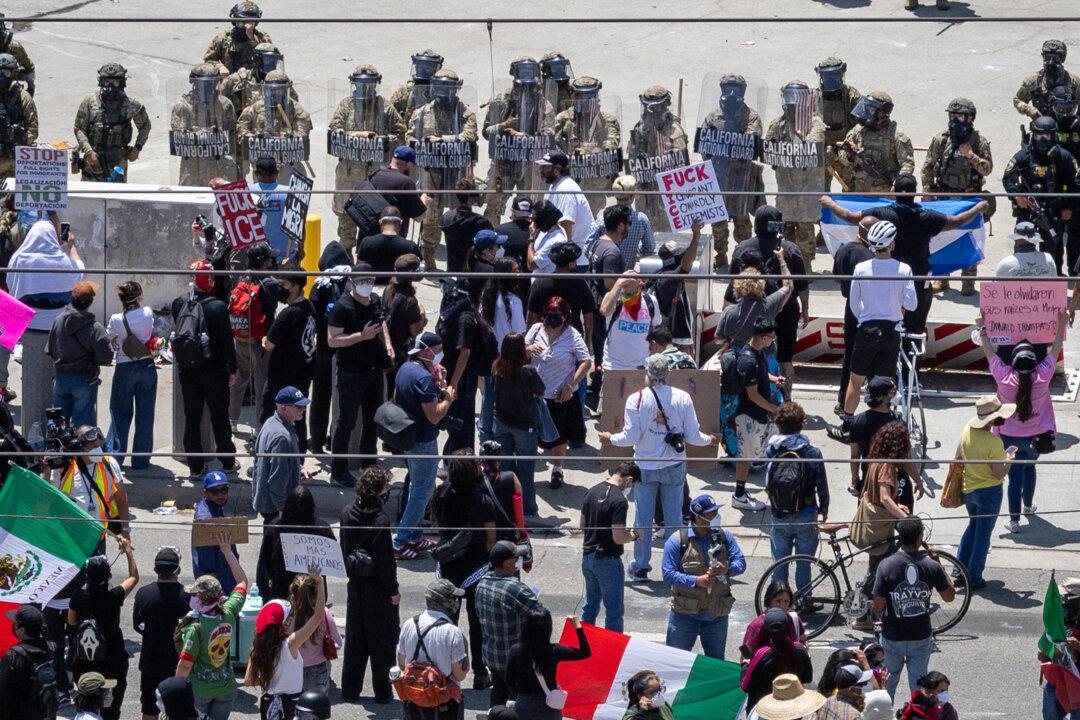The U.S. Supreme Court recently ruled that Immigration and Customs Enforcement (ICE) may continue to conduct enforcement operations at places suspected of harboring illegal immigrants while a lawsuit on the matter plays out in court.
The Sept. 8 order allows ICE to consider apparent race, language, and the type of work and workplace when performing the operations.
‘Random’ ICE Stops
Tackling illegal immigration was a key part of President Donald Trump’s campaign platform in 2024, and his second term has seen an increase in deportations.
ICE agents pinpointed construction sites, farmers markets, and home improvement stores where temporary day laborers were known to congregate in search of work.
Protests followed. Those protests eventually turned into riots, leading Trump to send in the National Guard.
Los Angeles Mayor Karen Bass said the operations were being done at “random” and had left the immigrant community “terrorized and terrified.”
She described ICE’s work as “masked men without uniforms, unmarked cars, no license plates, [who] jump out of cars with guns and just snatch people and detain them off the streets, grabbing people off of bus stops.”
The Lawsuit
Pedro Vasquez Perdomo, along with two other men, was arrested by immigration authorities at a bus stop on June 18.
Vasquez Perdomo filed suit, along with several other individuals and two immigrant advocacy groups: Coalition for Humane Immigrant Rights and Immigrant Defenders Law Center.
On July 11, U.S. District Judge Maame Ewusi-Mensah Frimpong ruled that ICE was wrongly targeting suspected illegal aliens based on four factors: their apparent race or ethnicity, their use of Spanish or English with a Spanish accent, their presence at a certain job location, or their job type, such as farm or construction work.
District Court Ruling Is Halted
The Trump administration filed an emergency appeal to the Supreme Court on Aug. 7, and on Sept. 8, the court blocked the lower court ruling, 6–3.
The majority ruling gave no explanation or written opinion. However, Justice Brett Kavanaugh—concurring with the majority—did explain his thoughts on the case in a separate written opinion.
Noting that an estimated 10 percent of Los Angeles’ population is illegal immigrants—about 2 million people out of 20 million—Kavanaugh wrote that it was no surprise that the federal government would focus on that area of the country.
“Immigration stops based on reasonable suspicion of illegal presence have been an important component of U.S. immigration enforcement for decades, across several presidential administrations,” he wrote.
“Whether an officer has reasonable suspicion depends on the totality of the circumstances.”
He wrote that ethnicity alone cannot provide “reasonable suspicion” but that it can be considered alongside other factors.
Kavanaugh also wrote that just because immigration laws have not been consistently enforced across different presidential administrations, it does not mean that judges can block the current administration from doing so.
“The judiciary does not set immigration policy or decide enforcement priorities,” he wrote.
Justices Sonia Sotomayor, Ketanji Brown-Jackson, and Elena Kagan dissented.
“The government, and now the concurrence, has all but declared that all Latinos, U.S. citizens or not, who work low-wage jobs are fair game to be seized at any time, taken away from work, and held until they provide proof of their legal status to the agents’ satisfaction,” Sotomayor wrote in her dissent.
What’s Next?
The case is headed to the Court of Appeals for the Ninth Circuit for reconsideration.
“Very soon, we’ll be back in court continuing the fight against these obviously illegal policies, and we’re confident that the judge will once again see, as she already saw that there is absolutely nothing legal about ICE targeting people based on their race, how they speak or their profession,” Angelica Salas, executive director of Coalition for Humane Immigrant Rights, said after the ruling.
The Supreme Court has not yet agreed to hear the case, but Kavanaugh wrote that if the government loses in the Appeals Court, the justices will likely take it up.
The Trump administration released a fact sheet at the end of last month, touting the arrest of 5,000 illegal immigrants in Los Angeles since June.











